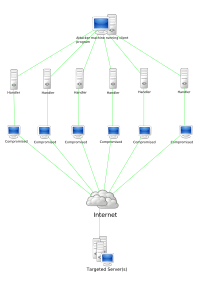
Photo from wikipedia
This paper is concerned with the detection of malicious attacks during the operation of switched systems. A novel game-theoretic switching detection scheme is proposed where the switching between subsystems is… Click to show full abstract
This paper is concerned with the detection of malicious attacks during the operation of switched systems. A novel game-theoretic switching detection scheme is proposed where the switching between subsystems is constructed aiming to reveal the existence of malicious attacks. The Kullback-Leibler (K-L) divergence between the legitimate and potentially falsified innovations is utilized as the stealthiness metric. Thereupon, a Stackelberg game is established to characterize the competition for stealthiness without any a priori restriction on the antagonistic attacker. Furthermore, the Stackelberg equilibrium switching strategy of the detector is implemented to orchestrate the activation among subsystems during the detection procedure, and the K-L divergence corresponding to the Stackelberg equilibrium is adopted as the detection threshold. Finally, as an example, a continuous stirred tank reactor is employed to demonstrate the effectiveness and applicability of the proposed results.
Journal Title: IEEE Transactions on Network Science and Engineering
Year Published: 2023
Link to full text (if available)
Share on Social Media: Sign Up to like & get
recommendations!